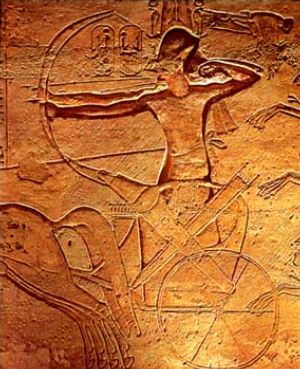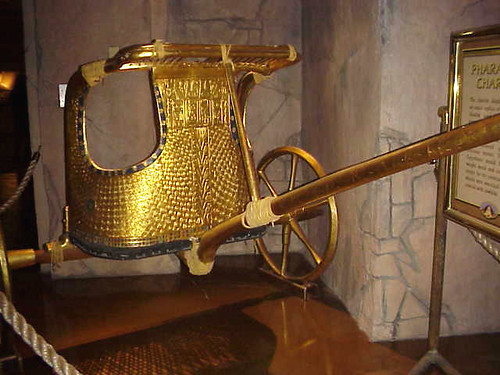By 3000 B.C. the art of Egypt was so ripe and so far advanced that it is surprising to find any student of early culture proposing that the crude contemporary art of the early Babylonians is the product of a civilization earlier than that of the Nile.
-James H. Breasted
This third blog will center on a warrior from the past, who is instantly recognizable the world over, even though their armaments and tactics were taken from the very cultures that beset Egypt in ancient times.
When one thinks of the ancient Egyptians, they immediately call to mind the Pyramids at Giza, the Sphinx, the temple of Ramses at Abu Simbel, and usually, this image…
Which is interesting, because the Egyptians did not invent the chariot, they observed, defeated, and recreated it from their conflicts with the Hyksos invaders in the 16th century BC. The chariot comes from 3000 BC in Mesopotamia, as an adaptation of the eariliest form of wheeled vehicle. The four best specimens of Egyptian chariots are those recovered from the tomb of Tutankhamun.
Other cultures and civilizations made use of the chariot in ancient times, but due to the rocky terrain in Europe and Asia, it was used more as a vehicle of royalty or sport instead of warfare. The fact that it was also an prone to structural failures probably further limited its military use outside of the fertile crescent.
We can infer that the ancient chariots were also somewhat unstable due to their single axel, and considering this, along with the vast number of images depicting chariot archers, that their tactical use was simple, but effective. If a large enough number of chariots armed with archers were able to ride towards a target enemy formation of foot-soldiers or cavalry, the archers would simultaneously fire toward the enemy formation in an arching pattern, thereby increasing the likelyhood of an arrow stiking home.
If the archers were unable to halt the advance of opposing foot-soldiers, the horses could simply trample them, and if the opponents were riding horses, the charioteers would likely have been able to outrun enemy cavalry briefly, allowing the archer a closer shot. The Battle of Kadesh has been theorized to have been the largest chariot battle in history, with some 5000 or 6000 chariots participating.
The Egyptian longbow, also known as the angular bow, was the primary reason behind the success of the chariot in Egypt. After all, you cannot have an archer, without a bow. The following is a video on the construction and power of the angular bow.
Egyptian arrows, which have been recovered in large numbers, and often in a very good condition, are very intriguing. They were usually about 0.35-0.5 ounces, between 30 and 33 inches long, and made of a slender reed giving a large deflection. The ability of the arrows to make deep and lethal wounds is vouched for in several tests, and is believed since they remained the standard equipment of the Egyptian army for several centuries. Although some suggest that since the arrows were so light, and the bows not quite as powerful as those found today, that the reason behind the chariot archers’ destructive force, was the skill of the archer in shot placement. Considering the strain of the bow, the instability of the moving chariot, and the unpredictable movement of the enemy, I would consider the Egyptian chariot archer quite skillful indeed.
References




Very informative post about the development of the chariot as a tool of warfare. Far too often does the modern world neglect to understand how such objects originated in the great civilizations of the past, believing them to, like you have described, to have originated from that particular civilization first. There are those today though that seek to correct that mistake, and as a military historian I encourage this activity heavily.
ReplyDeleteRegarding the strengths and weaknesses of the chariot archers, I believe that there is an element of physics that has been left out of discussion. The momentum of the chariot as it advance, combined with the skill of the archer to produce enough force with his bow, certainly played a hand in the effectiveness of the chariot archers. I believe the show "Weapon Masters" once detailed this reasoning. Like their brethren who would swing at the enemy with swords, axes, or spears, chariot archers surely must have used momentum to their advantage. I do ponder if they used the same chariot designs as the regular chariot infantry, or if theirs were designed to be lighter in construction. To add to this thought, were their chariots ever given blades on the sides to cut through enemy ranks?
What astounds me to this day however is the resourcefulness of past Armorers. Using reeds as a material for arrows, is something most individuals do now picture when they hear the word arrows. Why we cannot find such low cost ways to produce effective weaponry today is a question that should be asked worldwide. I wonder as to how the reeds were selected for arrow use. Did certain regions of Egypt produce more favorable reeds, or was it just a universal concept? Furthermore, was it an art form or more of a lowly task for slaves to assemble? These are the kind of questions that I would ask the researchers who have looked into these practices.